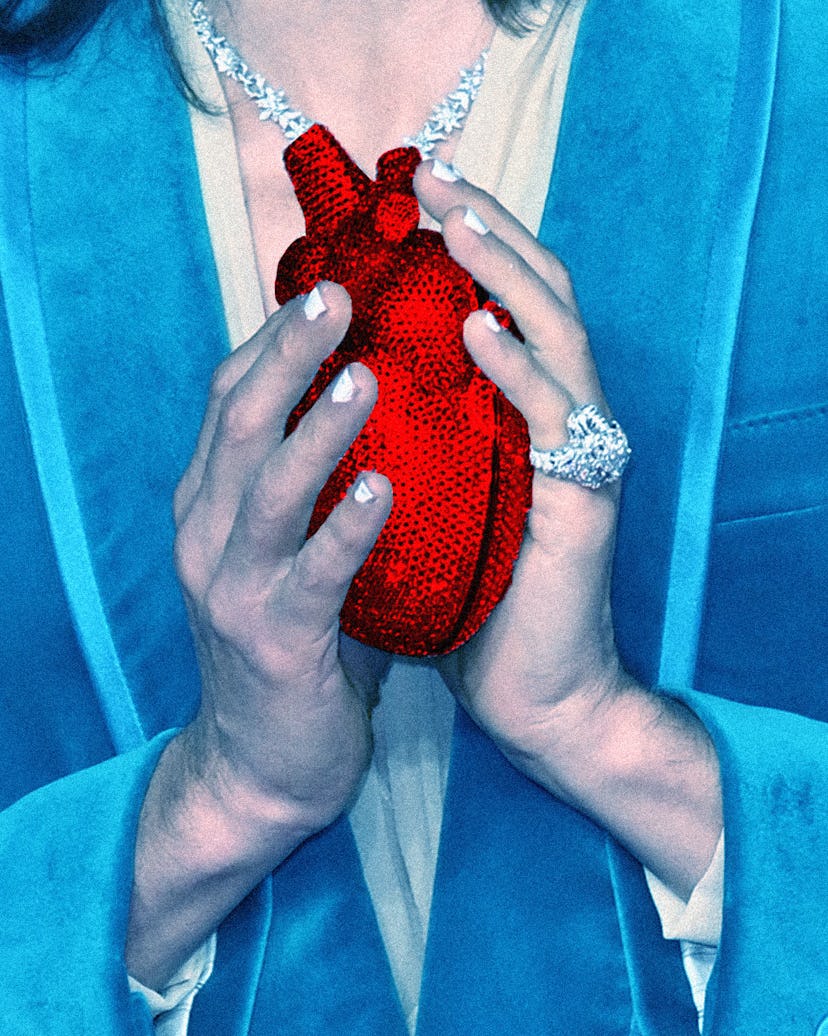Inside the Latest Heart-Shaped Fashion Trend
Coming out of the pandemic, it’s no surprise to see a warm, comforting motif start to make a comeback.

Why is heart-shaped fashion suddenly popping up everywhere? When Gucci debuted its Aria collection earlier this year, a crystal-covered anatomical heart clutch from the presentation made waves on the Internet. Since then, its celebrity attraction has been undeniable, with Amandla Stenberg, Lou Doillon, and most recently, Jared Leto, carrying the accessory on the red carpet. Chanel debuted pastel quilted flap bags in the shape of chunky hearts on the spring 2022 runway to equal fanfare. Elsewhere, Vivienne Westwood, Ashley Williams, Coperni, Yves Saint Laurent, and GCDS recently sent out love letters in the form of heart-shaped bags.
The heart shape as a motif is impossible to ignore in fashion right now. Isabel Marant, Balenciaga, Acne Studios, and Y/Project have all put a focus on heart earrings, alongside indie brands like Emma Pills, which sells a shiny pair of crystal fringe heart baubles; Stinky Jewelz (a favorite of Olivia Rodrigo), makes glossy heart pendants on a string of pearls and studs. But what makes the heart-shaped bag in particular so interesting is its unique history.
The heart shape as we know it is thought to have come to fruition through the work of artists and scientists of the Middle Ages, as they reinterpreted ancient medical texts. “The heart as a symbol of love has very deep roots, dating back to 14th-century courtly love traditions through Shakespearean times,” says fashion historian Michelle Finamore.
Jewelry has long embraced the heart. “Brooches signifying fidelity and love date to C. 1400,” adds Finamore. That includes “heart-shaped amulets and talismans that were thought to be imbued with protective qualities, and 17th-century rings with hearts that were given as tokens of affection.”
Yu Masui outside Ester Manas on October 2, 2021 during Paris Fashion Week.
Yet the stylized heart we know and love today is closest to its 18th- and 19th-century representations. In fact, chocolate businessman John Cadbury’s son, Richard, was the first to sell chocolates in a heart-shaped box, which would kick off the future of the heart standing as a symbol for love and romance. And along with that came a cadre of people who donned the heart in a whole host of ways. The Victorian era marked a period of time when the heart-shaped locket became incredibly popular; people stored locks of hair from loved ones inside the jewelry. Although not explicitly a purse, this may have been the very first attempt at a heart-shaped bag.
Hearts throughout fashion can be seen everywhere from the early Surrealists of the 1920s (including Elsa Schiaparelli), to the 1940s—Finamore notes that a sweater worn by Ginger Rogers in the 1938 film Carefree designed by Howard Greer is one of the most famous examples. In the 1960s, the bejeweled heart became a personal talisman to the designer Yves Saint Laurent, who later reinterpreted the shape over and over again. The 1980s showed the heart en masse on novelty t-shirts alongside high-end wears—epically embellished dresses by Christian Lacroix. And who could forget the famous red heart bag by Moschino, worn by Fran Drescher in The Nanny in the 1990s?
Fran Drescher in The Nanny.
But what’s the reason behind the sudden heart bag obsession? The explanation could have to do with fashion subcultures. Styles dubbed Cottagecore and Dark Academic marked 2020 as a year of alternative expression. Now, we’re seeing the next evolution of those subcultures in the form of categories like Lovecore, or Regencycore, which fans of Bridgerton embraced in early 2021, and continues on, as communities of Nap Dress lovers rise up. The softer, girlier side of Lovecore could even be seen on the runway in the form of Moschino’s spring 2022 collection, which was full of kawaii baby animal prints paired with heart bags.
Jeremy Scott and Anitta arrive at the amfAR Gala in Los Angeles on November 4, 2021 wearing Moschino spring 2022 ready-to-wear.
Fans of the heart bag may not intrinsically realize it, but the motif speaks to something much deeper than subcultures. It has everything to do with dressing for psychological comfort during a time when things are still incredibly uncertain. A stiff leather tote doesn’t quite have the same vibe as a baby pink heart bag with a pearl chain, after all. “Generally speaking, the heart motif evokes feelings of kitsch, comfort, fun, playfulness; overall happy associations,” says Mandy Lee, trend cycle analyst. “Coming out of the pandemic, it’s no surprise to see a warm, comforting motif start to make a comeback.”
“History does often repeat itself, particularly in times of crisis, and particularly in fashion,” Finamore adds. “I think that with the real-life fears related to the Covid-19 pandemic and environmental concerns, embracing symbols of love feels comforting.”
Jared Leto attends the U.K. premiere of House of Gucci at Odeon Luxe Leicester Square on November 9, 2021 in London, carrying Gucci’s anatomically correct heart-shaped clutch.
Interestingly enough, the next evolution of the heart-shaped bag might be going in a more anatomical direction, à la Gucci. “Anatomical heart imagery began to rise in popularity in the mid 2000s-early 2010s, specifically in alternative subcultures, and became a popular tattoo design,” explains Lee, whose analysis on why the Indie Sleaze style of the 2010s is making a comeback went viral on TikTok. “It’s a stark contrast to the anatomically incorrect scalloped heart shape we’re all familiar with.”
But for Emma Pillemer, the designer behind Emma Pill, the shape is, and has always been, about nostalgia. “I’ve always loved heart jewelry,” she explains. “I think because my mom wears a heart diamond necklace and my whole childhood, I loved it. The shape of a heart is so beautiful, but also gives good energy and in some ways, hopefully, spreads love.”